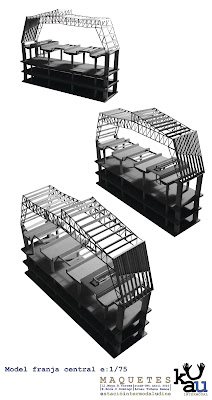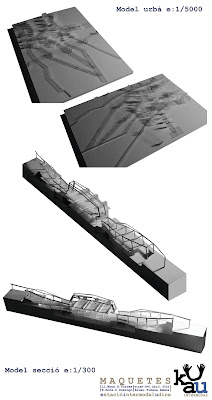>> Intermodal station in Udine / Projecte final de carrera / Master Thesis
>> Tutors / Profesors: Mamen Domigo, Estanislau Roca, Lluís Moya, Ramon Torres.


>> Projecte final de carrera / Master Thesis























The multiscalar and hybrid condition of the territory has been basic idea to develop a project that wants to have a global character, in response to urban dynamics, but at the same time, be open and responsive to particular events.
The plain of Friuli-Venezia-Giulia, in Italy Mediterranean sea and the south of the Alps and has been an essential point for the commercial routes of the South of Europe. Udine Friuli , was based as a commercial and interchange key point, and actually, is still a basic node for transport network between the west and the east of Europe .
With the advent of the railway, the old city of Udine enters in a new stage in which the concept of a compact and dense downtown against a natural territory give rise to a new urban-territorial reality that works with several scales. The development of Udine can be understood as the grow of a city in two movements and speeds: In a small scale, the slow, consistent and dense historic-downtown, and in a large scale, the fast and light railway tracks, that were build together with steel factories and other industrial buildings.
The railway blocked Udine
The aim of the project is to link the two parts that actually remain divided recovering that old industrial area, transforming the old factories into public equipments in order to be permeable to the natural flows, allowing the nort-south connection and the city to grow to the south, dissolving and exploiting the potential of the railway at the same time .
The aim of the project is to link the two parts that actually remain divided recovering that old industrial area, transforming the old factories into public equipments in order to be permeable to the natural flows, allowing the nort-south connection and the city to grow to the south, dissolving and exploiting the potential of the railway at the same time .
The strategy is to read the city through the fluxes and energies.
In one hand, the ways north-south that come fromUdine. Udine
On the other hand, characterized by speed and sequentiality, infrastructural east-west traces are a good opportunity to take up new activities, not only along and near the lines, but also over and under them, using functional stratification between speeds and activities.
The intersection of these perpendicular flows crystallizes in to the node of the station, organized by a system of static and dynamic overlays.
More than a building designed for waiting, the station is designed as a multi layer infrastructure where there are interchanges between transports at different speeds and between the two parts of the city, working with the ground as an urban material to establish a new urban condition.
>> AWARDS
[Projecte Seleccionat]
[1er Premi]
>> LINKS
>> HIC
>> XI BEAU
>> DIARI
>> INFORMACIONS UPC
In one hand, the ways north-south that come from
On the other hand, characterized by speed and sequentiality, infrastructural east-west traces are a good opportunity to take up new activities, not only along and near the lines, but also over and under them, using functional stratification between speeds and activities.
The intersection of these perpendicular flows crystallizes in to the node of the station, organized by a system of static and dynamic overlays.
More than a building designed for waiting, the station is designed as a multi layer infrastructure where there are interchanges between transports at different speeds and between the two parts of the city, working with the ground as an urban material to establish a new urban condition.
>> AWARDS
[M.H]
[Projecte Seleccionat]
[Projecte Seleccionat]
[2on Premi]
[1er Premi]
-2012. Premis AJAC 2012. Primer Premi en modalitat Projectes Final de Carrera.
>> HIC
>> XI BEAU
>> DIARI
>> INFORMACIONS UPC

